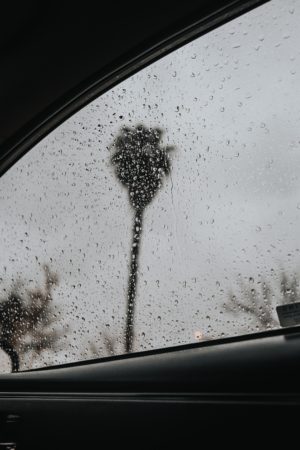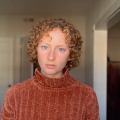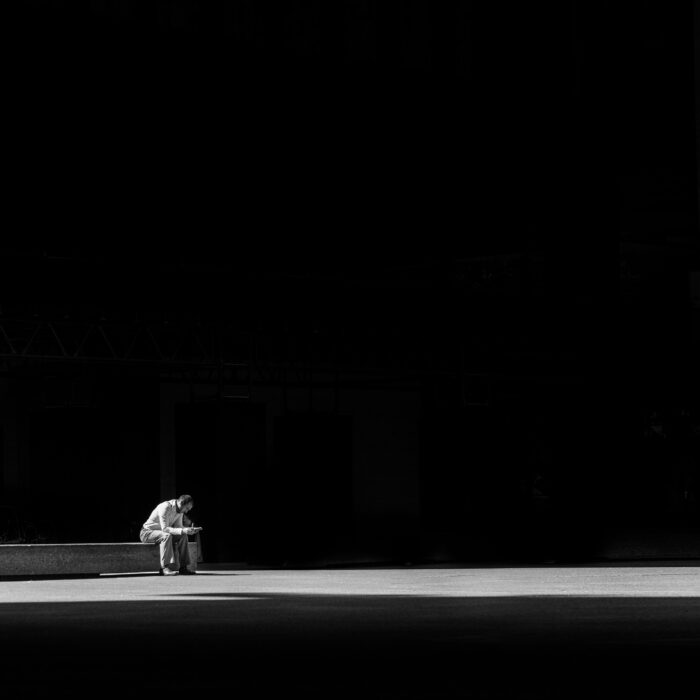You have no items in your cart. Want to get some nice things?
Go shopping
In March 2020, the world drew to a halt. An unprecedented stasis. Many grasped for metaphors. Weathered trenches, invisible enemies, barricades of N-95 masks. But analogies keep falling short. Instead, let’s start with an image.
Image no. 1:
Day after day, my Grandmother, P, emails me photos of the tree blossoming outside her bedroom window in Long Island. She is 89 and too scared to go outside to take the photo from street view. She, like many of us, fears becoming the positive space in public health models of catastrophe. So instead P remains locked behind tall glass windows, taking pictures of the neighbor’s backyard, and stitching angles of branches together in Photoshop. Each doctored image resembles a photograph of a cherry-blossom tree in a snow globe. Pale pink flowers enclosed within an atmosphere of glass.
Then, in the United States, being locked indoors meant live on one side of the biopolitical coin of life and death. Incessantly checking the news, “working from home,” distracting from grief: we find coping mechanisms that shut away a pandemic. For the privileged, shelter in place might be the most mundane articulation of biopolitical care. Shut away from an increasingly lethal world – made to live – as so many others are left otherwise: the essential workers, the incarcerated, the houseless, the elderly, the refuse of a gig economy. But unless you were losing kin, it was difficult to sense a state of emergency.
And yet were told that the air is more lethal than usual. A virus was filling the atmosphere with sharp shards of glass that will, depending on your life chances, lacerate the alveolus wall, scar the respiratory track tissue, and block oxygen from entering the blood flow. It seemed the whole world has become an atmosphere of glass. If you listened closely you might hear someone gasping, repeatedly, for air.[i] But for those of us at home, the noise was usually blocked out by the newly thickened particles.
This silence was misleading. Outside war proceeded noisily apace. Every nation claimed to be battling the same combatant. “We must defeat an invisible enemy,” men in suits announced to millions clutching their screens, “we are stockpiling ammunition.” Such proclamations were unsurprising: biopolitics has always been a war, if not an outright massacre. And it is not the first-time disease has served as its battlefield. Rather than decrying such comparisons, we might try taking metaphors for their word.[ii] What follows makes a case for apprehending disease as war. And in so doing, urges for modes of representation that can more carefully account for this violence.
Image no. 2:
When P is not languishing with her camera pointed out the window, she calls her sister, my Great Aunt S, in Los Angeles. S cannot leave her room in the nursing home she lives in because upwards of 20 residents have died from COVID-19 in recent weeks. Instead she nests amidst knock-off Louis Vuitton handbags, faded black and white portraits, Persian carpets, hair, and clothing. P and S talk for hours on end – together they tally the dead. A ritual kind of mathematics the sisters, having confronted mass death 75-years prior, are practiced in. Phyllis distills their daily accounting in her emails to me, as if to remind me that springtime’s life impulse is fertilized with the ashes of the dead.
Biopolitics is a lethally anonymous form of care, in so far as such “care” only cares for life as if it were not the singularity of human life at all (Stevenson 2014). The life biopolitics makes live is the stuff of abstraction: points that stretch or flatten population curves. History shows that staying alive is quite different than living. Liberal regimes of governance have long fought wars in the name of preserving life. The frontlines of colonial public health functioned, also, as the expanding imperial or settler colonial frontier. Climate, land, and native were discursively collapsed into a single diseased and inhospitable substance only the White Man’s alchemy could transform (Comaroff 1993, 307). Contemporary warfare remains as humanitarian as ever. Medical metaphors subtend counterinsurgency doctrine: a drone’s surgical strike likened to a tripartite medical procedure aiming to save a diseased body without leaving too much collateral damage (Gregory 2008) A few miles away from the moveable trailers housing drone operators in the American Southwest, the semantic structure of disease abets the continuation war – by other means (Garcia 2014).
If biopolitical care is a form of war, then disease often figures as its most lethal battleground. To be made to live is to exist, not as an individual life, but as a specimen encased in glass: an anonymous archive of government efficiency. You may struggle endlessly to breathe, but noise cannot travel through solid atmosphere. In such hostile environments, war metaphors simply exacerbate the lethal obfuscation of the biopolitical state. The dead enumerated as the collateral damage of unending battle rather than the singularity of a life. So rather mobilizing the same discursive formations, we might attend to biopolitics’ causalities differently.
Image no. 3:
My father calls me from the other side of the country to tell me that S is in the hospital. Something about too many sleeping pills and falling off her bed breaking her hip. He says “She’s stable, she’s breathing.” I ask more questions. “It sounds like she tried to kill herself,” he offers, “she was out of it the past few months.” The words sound hollowed out by their own inadequacy. In the silence that follows, I picture S finally giving herself over to thousands of images of death collected over a lifetime. A surrender as simple as taking a handful of pills. P does not answer the phone when I call her. Nor does she send me pictures of the cherry blossom tree outside of her window.
How might one represent biopolitical war reparatively?[iii] Image as method offers an immediacy that cuts through numerical abstraction. Like turning the pages of a photo-album, gazing carefully at each picture, sitting with the lacerating emphasis of a detail, getting lost in time. Rather than discursive certainties, images offer the possibility of taking you hostage, captured by the minor elements that sabotage accurate stories.
In times of warfare – epidemics, pandemics, and other forms of slow, intractable violences – writing that takes image as its method challenges the lethal forms of care dictated by the biopolitical state. Picture and text offer up precipitates of experience; an imagistic register delivers life in its singularity.[iv] “Every photograph,” Roland Barthes (1981) once observed, “is a certificate of a presence” (87). The image as method is a refusal to reduce living to a matter of enumeration, a refusal to traffic in the same language as the biopolitical state. To write of biopolitics’ causalities with images is thus to preserve the irreducibility of a life: it scrapes away at accretions of anonymity. It is, above all else, a kind of care (Stevenson 2014).
The image as method thus offers as much a biopolitical as an onto-epistemological provocation. Life and death are not simply matters of adding or subtracting to population registries, not simply lines peaking as public health crises or flattened into ordinary crises. Images of biopolitics’ causalities enliven social forms.[v] Images, Walter Benjamin once wrote, “are that wherein what has been comes together in a flash with the now to form a constellation.” In other words,” he wagered, “image is dialectics at a standstill” (1969, 462). Writing that takes image as its method presents scenes which explode the dictations of metaphors. The past interrupts the present to posit a different possible future. To write of biopolitics with images is to write worlds into being.
Image no. 4:
A few days later, P sends me a photo of Aunt S. A nurse in the hospital sent it over iMessage since no one can get inside to pay her a visit. S’s impossibly platinum blonde is hair faded into grey, her usually painted lips a pale purple, and her eyes roll back into the darkness of her cranium. This time there is no tally of the dead beneath the image. The caption simply reads: “S is Doing okay. In for Hip Surgery. A little out of it.” The edge of the nurse’s finger, a smudge of pale-pink cherry blossoms slightly mars the composition.
Biopolitics justifies war by monopolizing metaphors. Life and death are stripped down to a matter of calculation: immense violence obfuscated as collateral damage or rationalized as the price of a future well-being. Such abstractions kidnap perception, enclosing our senses in atmospheres of glass. Our capacity to apprehend the scope and scale of life sacrificed, let alone offer up a form of care, is stifled. Today our social worlds are suffocating for want of breath.
An image, I have argued, collapses the space between original and referent so that there is no room for analogies let alone abstraction. “In photography,” Roland Barthes writes, “the presence of the thing is never metaphoric” (1981, 78). You are confronted with the plenitude of a subject or a scene that refuses to be made into something else. The image holds the viewer in its irreducibility, demanding they keep looking.[vi] Attention indexes not only a form of intimacy but also a dependency between observer and observed. To be held by such images is to be held by life itself.[vii]
Today, as death is all around us, metaphors of war threaten to efface the lives slipping by outside. To present the images of these scenes of loss is to refuse to think of those already taken from this world, as well as those forced to put their wellbeing on the line, as anonymous points in a population curve. Enumeration is no form of care, let alone mourning. Instead, we might allow ourselves to be held by certain images. Gripped by the intensity, and singularity, of life itself.
Image no. 5:
The last time I saw Aunt S we flipped through the photo albums stored in my Grandparent’s basement before Passover Seder. A ritual handling of those faded images that function as a requiem to past lives. After one gin martini, everyone gets tired of the ceremony. “Put those away” my Grandfather muttered, “what’s the use of looking at those anyway.” Today, however, the only way to tend to the dead or dying is to care for their images. We witness ourselves paying homage to the deceased on glass screens – wakes, shivas, and funerals broadcast live on facetime, zoom, shiva.net, and viewneral.com. Amidst a saturation of images, it becomes ever more imperative to sit with particular ones, getting lost in the details, which also contain the fullness of a life lived.
*
Works Cited:
Anderson, Warwick. Colonial Pathologies: American Tropical Medicine, Race, Hygiene in the American Phillipines. Durham and London: Duke University Press. 2006.
Benjamin, Ruha. “Catching our Breath: Critical Race STS and the Carceral Imagination. Engaging Science, Technology, and Society 2 (2016), 145-156.
Benjamin, Walter. Illuminations: Essays and Reflections. London: Penguin Books, 1969.
Foucault, Michelle. The History of Sexuality. London:Routledge Press, 1978.
Barthes, Roland. Camera Lucida: Reflections on Photography. New York: Hill and Wang, 1981.
Comaroff, Jean. “The Diseased Heart of Africa: Medicine, Colonialism, and the Black Body”. In S. Lindenbaum & M. Lock (Eds.), Knowledge, Power, and Practice: The Anthropology of Medicine and Everyday Life. (pp. 305–329). Berkeley: University of California Press, 1993.
Garcia, Angela. The Pastoral Clinic: Addiction and Dispossession Along the Rio Grande. Berkeley: University of California Press, 2010.
Gregory, Derek. “‘Rush to the Intimate’ US Counterinsurgency and the Cultural Turn.” Radical Philosophy. 2008.
Lakoff, George and Mark Johnson. Metaphors We Live By. Chicago: University of Chicago Press, 1980.
Mbembé, Achille. & Meintjes, L. “Necropolitics.” Public Culture 15(1), 11-40. 2003.
Pandian, Anand. A Possible Anthropology: Methods for Uneasy Times. Durham and London: Duke University Press, 2019
Prakash, Gyan. Science and the Imagination of Modern India. Princeton: Princeton University Press, 1999.
Rabinow, Paul et al. Designs for an Anthropology of the Contemporary. Durham and London: Duke University Press, 2008.
Sharpe, Christina. In The Wake: On Blackness and Being. Durham and London: Duke University Press, 2016.
_____________. “Anti-Black Weather vs. Black MicroClimates. Interview by Leopold Lambert. The Funambulist. No. 14November-December 2007.
Stevenson, Lisa. Life Beside Itself: Imagining Care in the Canadian Artic. Durham and London: Duke University Press, 2017.
Tsing, Anna. “Unruly Edges: Mushrooms as Companion Species.” Environmental Humanities, Volume 1. 2012.
[i] The intimacies between long-standing forms of structural violence and the contemporary pandemic might be apprehended through the rubric of breath. Indeed, Christina Sharpe (2016; 2017) frames the afterlife of slavery as a condition that withholds breath from those Black communities who live in its wake. Sharpe (2017) frames Eric Garner’s famous last words “I Can’t Breathe” as an eventful manifestation of the quotidian experiences of unbreathability, “where really the ability to fully live in a Black body is continually curtailed, foreclosed, so that you can’t breathe” (52). Ruha Benjamin (2014) echoes this assertion, reminding that breathing is always an epistemic and political problem as racism and capitalism suffocate Black life (147). Beyond the visible forms of police brutality that take the lives of those like Eric Garner, there are the invisible, slow, and structural violences. Violences that manifest in the preventable deaths by asthma that take the lives of thousands of Black Americans each year, and today, a higher COVID-19 death rate among Black communities.
[ii] Lakoff and Johnson (1989) famously describe how metaphors function, not simply as poetic flourishes in everyday language, but structure how subjects perceive reality. To decry using military metaphors to stand in for COVID-19 risks overlooking how warfare has and continues to quite literally structure how disease and is perceived and treated.
[iii] Stevenson (2014) attends to the effects of past and present biopolitical regimes of public health among Inuit communities in the Canadian artic, using images as a method that refuses “discursive certainties,” foregrounding instead those scenes when “facts falter and when things (and selves) become, even just slightly unhinged.” In so doing she show how Inuit communities resist the dictations of the biopolitical state, caring for the living and the dead in a way that preserves the singularity of an individual life. If hers is an ethnography of care, it is also exemplary of how ethnographic representation can sustain forms care and community otherwise effaced by biopolitical rubrics of life and death.
[iv] Stevenson 2014, 184, 11
[v] Confronted with the existential quandary of representing the intense suffering she observes among heroin addicts in Northern New Mexico, Angela Garcia (2016) grasps onto images (34). Citing Ludwig Wittgenstein, Garcia provides a mode of “seeing life itself” by documenting the scenes of death she encounters (2010, 155). Garcia quite literally sets these scenes – Scene 1, Scene 2, Scene 3 – as if inserting a still shot from a movie into the text. Enlivening each scene of death with imagistic detail, the singularity of the life at stake in each case is fully apprehended, as are the kinds of intimacies and socialites sutured in the wake of loss. Neither glossed as statistic nor ventriloquized as ethnographic sign, made to stand in for something else, the death she documents is also a form of life (181).
[vi] Barthes describes photographs as having the capacity to take “hold” of him, as the force of the image – what he calls its third meaning – eludes intelligibility (52). Stevenson characterizes this “hold” as that which remains after the symbolic and informational registers of an image have been exhausted: “that which makes you look and then look back again” (213).
[vii] Here I draw from Stevenson (2014) and Garcia (2010), who both cite Ludwig Wittgenstein, in their call to “see life itself” through ethnographic representation (Garcia 155, Stevenson 212). For both, images communicate the intensity of life as such – instilling ethnographic description with a generative capacity.

About Sophia Goodfriend
Sophia Goodfriend is a writer from Seattle Washington. She is currently pursuing a PhD in Cultural Anthropology at Duke University.



